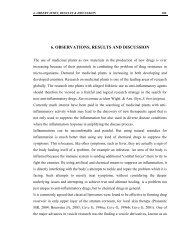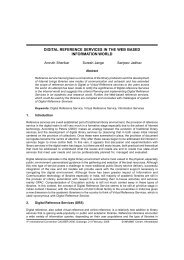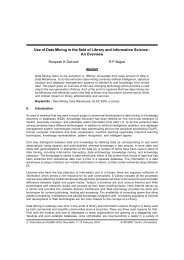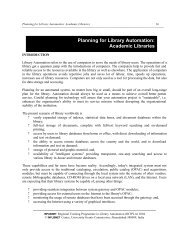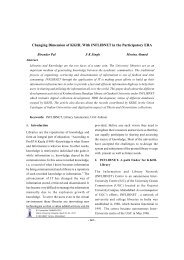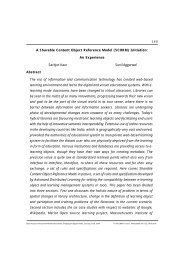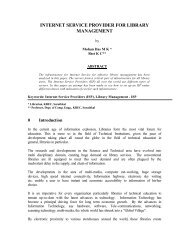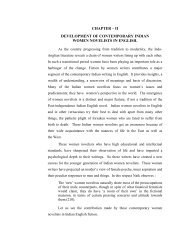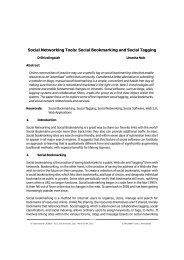Need for Materializing Future Technologies and Techniques in ...
Need for Materializing Future Technologies and Techniques in ...
Need for Materializing Future Technologies and Techniques in ...
Create successful ePaper yourself
Turn your PDF publications into a flip-book with our unique Google optimized e-Paper software.
520<br />
<strong>Need</strong> <strong>for</strong> <strong>Materializ<strong>in</strong>g</strong> <strong>Future</strong> <strong>Technologies</strong> <strong>and</strong> <strong>Techniques</strong> <strong>in</strong> Library<br />
Services <strong>for</strong> Effective In<strong>for</strong>mation Management<br />
K Veeranjaneyulu LSRCV Ramesh<br />
Abstract<br />
Aga<strong>in</strong>st the backdrop of the electronic age, new organizational structures are emerg<strong>in</strong>g. In<br />
order to be more efficient, effective <strong>and</strong> responsive organizations give prom<strong>in</strong>ence to the<br />
use of networks <strong>and</strong> computer based <strong>in</strong><strong>for</strong>mation systems. Likewise a data warehouse, a<br />
database system that is separate from the organizations onl<strong>in</strong>e transaction process<strong>in</strong>g<br />
system. Data m<strong>in</strong><strong>in</strong>g helps <strong>in</strong> discover<strong>in</strong>g mean<strong>in</strong>gful new corrections, patterns <strong>and</strong> trends<br />
by shift<strong>in</strong>g through, large repositories, us<strong>in</strong>g pattern recognition technologies as well as<br />
statistical <strong>and</strong> mathematical techniques. F<strong>in</strong>ally it is concluded that there is due need to<br />
materialize the future technologies to guide the future generations <strong>in</strong> a most effective way<br />
of Library Management.<br />
Keywords : In<strong>for</strong>mation Management, Library Services, <strong>Future</strong> <strong>Technologies</strong><br />
0. Introduction<br />
The virtual libraries evolved around the Internet <strong>and</strong> the websites have trans<strong>for</strong>med <strong>in</strong>to a base <strong>for</strong><br />
university education “back up services”. Web empowers its users; its most immediate impact has been<br />
to corrode <strong>in</strong>stitutional power. The web power is such that even be<strong>for</strong>e the newspaper arrives <strong>in</strong> the<br />
morn<strong>in</strong>g, the reports are read <strong>and</strong> judgments are passed on over the web.<br />
1. Versatile web dynamics<br />
The web’s exponential spread has became possible <strong>in</strong> a short span of time, because web can host<br />
cheap, convenient <strong>and</strong> better connected <strong>in</strong><strong>for</strong>mation through various visions of universities, shops,<br />
laboratories, conferences etc. For example the rapid movement of a stock market is dematerialized<br />
across the globe simultaneously <strong>and</strong> without any time lag. The community is be<strong>in</strong>g redef<strong>in</strong>ed <strong>in</strong> electronic<br />
terms. Even big bus<strong>in</strong>ess, despite its size, does not surpass the web <strong>and</strong> <strong>in</strong>evitably chooses to channelize<br />
the <strong>in</strong><strong>for</strong>mation.<br />
2. <strong>Future</strong> Vision<br />
Aga<strong>in</strong>st the backdrop of the electronic age, new organizational structures are emerg<strong>in</strong>g. The advents of<br />
strong external coalitions are trans<strong>for</strong>m<strong>in</strong>g traditional, monolithic centralized <strong>and</strong> hierarchical<br />
organizations <strong>in</strong>to loosely coupled organic networks. These organizational <strong>for</strong>ms are characterized by<br />
cooperation <strong>in</strong>stead of autonomy <strong>and</strong> control. Consequently, the structures felicitate <strong>in</strong>tense shar<strong>in</strong>g of<br />
<strong>in</strong><strong>for</strong>mation <strong>and</strong> a high level of <strong>in</strong>terpersonal <strong>and</strong> <strong>in</strong>ter organizational connectivity.<br />
Increas<strong>in</strong>gly, <strong>in</strong>dividuals <strong>and</strong> <strong>in</strong>stitutions are sett<strong>in</strong>g up such ‘transnational networks’ that pay absolutely<br />
no need to national boundaries <strong>and</strong> barriers. In order to be more efficient, effective <strong>and</strong> responsive<br />
organizations give prom<strong>in</strong>ence to the use of networks <strong>and</strong> computer based <strong>in</strong><strong>for</strong>mation systems. It<br />
appears that less security is applied to data held <strong>in</strong> computer systems then is the case <strong>for</strong> data held <strong>in</strong><br />
manual systems.<br />
2 nd International CALIBER-2004, New Delhi, 11-13 February, 2004 © INFLIBNET Centre, Ahmedabad
Veeranjaneyulu <strong>and</strong> Ramesh<br />
521<br />
3. Data warehous<strong>in</strong>g <strong>for</strong> decision-mak<strong>in</strong>g<br />
Data warehous<strong>in</strong>g offers a better approach by implement<strong>in</strong>g the process to access heterogeneous data<br />
sources; clean, filter <strong>and</strong> trans<strong>for</strong>m the data, <strong>and</strong> store the data <strong>in</strong> a structure that is easy to access,<br />
underst<strong>and</strong> <strong>and</strong> use. A data warehouse provides the base <strong>for</strong> the powerful data analysis techniques<br />
such as data m<strong>in</strong><strong>in</strong>g, onl<strong>in</strong>e analytical process<strong>in</strong>g (OLAP) as well as more traditional Query<strong>in</strong>g <strong>and</strong><br />
Report<strong>in</strong>g. Mak<strong>in</strong>g use of these techniques along with data warehous<strong>in</strong>g can result <strong>in</strong> easier access to<br />
organization’s critical <strong>in</strong><strong>for</strong>mation <strong>for</strong> more <strong>in</strong><strong>for</strong>med decision-mak<strong>in</strong>g.<br />
4. A data warehouse is typically a dedicated database system that is separate from the<br />
organization’s onl<strong>in</strong>e transaction process<strong>in</strong>g systems <strong>in</strong> that;<br />
a. It covers a much longer time horizon then does transaction systems.<br />
b. It <strong>in</strong>cludes multiple databases that have been processed so that the warehouse’s data are def<strong>in</strong>ed<br />
uni<strong>for</strong>mly <strong>and</strong><br />
c. It is optimized <strong>for</strong> analysis answer<strong>in</strong>g, complex quarries from direct users <strong>and</strong> applications.<br />
The basic applications are summarized as follows :<br />
1. Data explosion.<br />
2. Increas<strong>in</strong>g power <strong>and</strong> decreas<strong>in</strong>g cost of computer hardware.<br />
3. Amaz<strong>in</strong>g power of Desktops.<br />
4. Ever <strong>in</strong>creas<strong>in</strong>g power of Server Software.<br />
5. Push Technology.<br />
6. Competitive Bus<strong>in</strong>ess environment.<br />
7. Proliferation of Intranets <strong>and</strong> Web based applications.<br />
Build<strong>in</strong>g a data warehouse of library transactions, especially <strong>in</strong> big libraries, greatly helps the library<br />
professionals <strong>and</strong> librarian <strong>in</strong> many ways. For example, circulation control system <strong>in</strong> libraries generates<br />
large volumes of data such as the borrower details <strong>and</strong> documents borrowed by them. Library data<br />
warehouses if implemented on organization’s Internet coupled with the push technology not only would<br />
help to provide critical <strong>in</strong><strong>for</strong>mation to library professionals but also to the library users.<br />
5. Data m<strong>in</strong><strong>in</strong>g techniques <strong>for</strong> new patterns <strong>and</strong> trends<br />
Data m<strong>in</strong><strong>in</strong>g derives its name from the similarities between search<strong>in</strong>g <strong>for</strong> valuable <strong>in</strong><strong>for</strong>mation <strong>in</strong> a large<br />
database <strong>and</strong> m<strong>in</strong><strong>in</strong>g rocks <strong>for</strong> a ve<strong>in</strong> of valuable ore. While Data m<strong>in</strong><strong>in</strong>g is the process of discover<strong>in</strong>g<br />
mean<strong>in</strong>gful new correlations, patterns <strong>and</strong> trends by shift<strong>in</strong>g through large repositories, us<strong>in</strong>g pattern<br />
recognition technologies as well as statistical <strong>and</strong> mathematical techniques.<br />
There are many data m<strong>in</strong><strong>in</strong>g techniques available today. Data m<strong>in</strong><strong>in</strong>g methods <strong>and</strong> techniques may be<br />
categorized on the basis of data source <strong>and</strong> data model to be m<strong>in</strong>ed i.e. relational databases, transaction<br />
databases, object-oriented databases, deductive databases, spatial databases temporal databases,<br />
multimedia databases, active databases legacy databases, heterogeneous databases <strong>and</strong> Internets<br />
gigantic library (world wide web); the k<strong>in</strong>ds of techniques to be used <strong>and</strong> the k<strong>in</strong>ds of knowledge to be<br />
discovered.
522<br />
<strong>Need</strong> <strong>for</strong> <strong>Materializ<strong>in</strong>g</strong> <strong>Future</strong> <strong>Technologies</strong> <strong>and</strong> <strong>Techniques</strong><br />
6. Conclusion<br />
The virtual libraries with web-based operations have already evolved; the new technologies <strong>and</strong> techniques<br />
would certa<strong>in</strong>ly help <strong>in</strong> effective library management. The specific techniques like data warehous<strong>in</strong>g <strong>and</strong><br />
data m<strong>in</strong><strong>in</strong>g relevant to Library <strong>and</strong> In<strong>for</strong>mation Science are need to be materialized <strong>in</strong> near future. The<br />
data warehous<strong>in</strong>g <strong>and</strong> data m<strong>in</strong><strong>in</strong>g techniques dem<strong>and</strong> the preparation <strong>and</strong> presentation of data <strong>in</strong> an<br />
amenable <strong>for</strong>m. This <strong>in</strong>volves considerable work on the exist<strong>in</strong>g databases that are be<strong>in</strong>g used <strong>in</strong><br />
libraries.<br />
7. References<br />
1. Inman, W.H (1992). Build<strong>in</strong>g the data warehouse. John Wiley, New York.<br />
2. Gupta, V.R (1997). An Introduction to data warehous<strong>in</strong>g. Chicago systems Services Corporation.<br />
3. Zakne, O.R (1999). Pr<strong>in</strong>ciples of knowledge discovery <strong>in</strong> databases CMPUT 690. University of Alberia.<br />
4. Nylund, A (1999). The Art <strong>and</strong> Science of M<strong>in</strong><strong>in</strong>g data Enterprise. Bus<strong>in</strong>ess 1.<br />
5. Piatetsky-Shapiro, G <strong>and</strong> Fraulley, W.J (1991). Knowledge Discovery <strong>in</strong> Databases. AAAI/MIT.<br />
6. International Technical Support Organization (1998). Data model<strong>in</strong>g techniques <strong>for</strong> data warehous<strong>in</strong>g<br />
SG 24-2338-00. Cali<strong>for</strong>nia IBM.<br />
7. Mexon, B (1996) Def<strong>in</strong><strong>in</strong>g data m<strong>in</strong><strong>in</strong>g DBMS ONLINE. DBMS Data warehouse supplement.<br />
8. Banerjee, K (1998). Is Data m<strong>in</strong><strong>in</strong>g right <strong>for</strong> your library? Computer <strong>in</strong> Libraries 18 (10).<br />
9. Venkataramana, V <strong>and</strong> Varatha Rajan, N (2001). Evolution of web university <strong>in</strong><strong>for</strong>mation centers : The<br />
perspectives of <strong>in</strong>novative technology. Paper presented at 46 th ILA Sem<strong>in</strong>ar at Ahmedabad 3-6 January<br />
2001. 348-353pp.<br />
10.Nageswara Rao, K <strong>and</strong> Rangaswamy (2001). Date warehous<strong>in</strong>g <strong>and</strong> Data m<strong>in</strong><strong>in</strong>g : <strong>Future</strong><br />
technologies <strong>and</strong> techniques <strong>for</strong> In<strong>for</strong>mation Management <strong>and</strong> Decisio mak<strong>in</strong>g <strong>in</strong> libraries. Cit opt.<br />
367-377pp.<br />
About Authors<br />
Dr. K. Veeranjaneyulu is Senior Assistant Librarian, College of Fishery Science,<br />
ANGR Agricultural University, Muthukur – 524 344, Nellore, India. He holds MLISc,<br />
<strong>and</strong> Ph.D. <strong>and</strong> published several articles <strong>in</strong> various conferences <strong>and</strong> journals. He<br />
organised <strong>and</strong> attended several conferences <strong>and</strong> tra<strong>in</strong><strong>in</strong>g programmes.<br />
E-mail : ru_123@rediffmail.com<br />
Mr. LSRCV Ramesh is at Extension Education Institute, ANGR Agricultural University,<br />
Hyderabad – 500030, India




